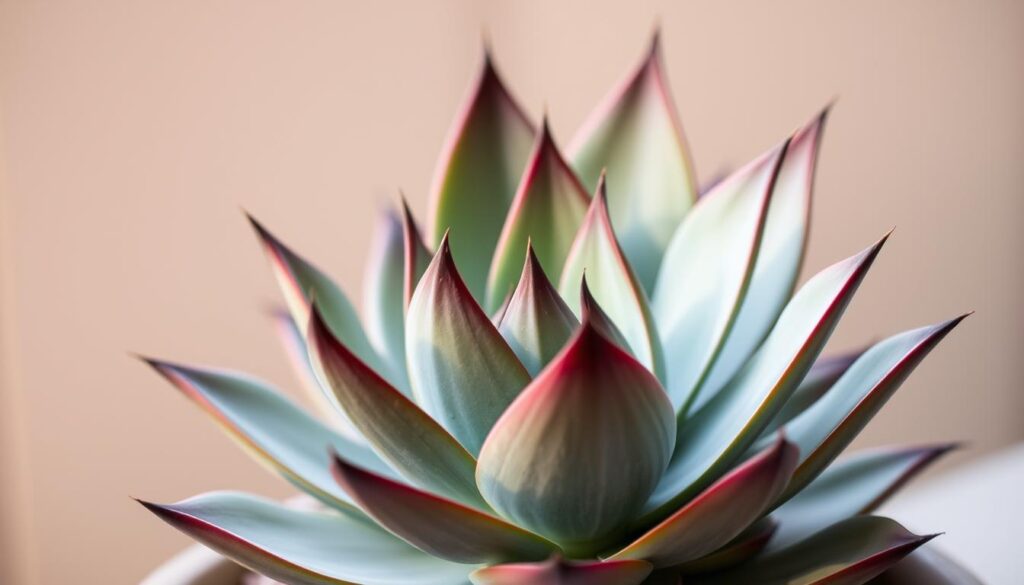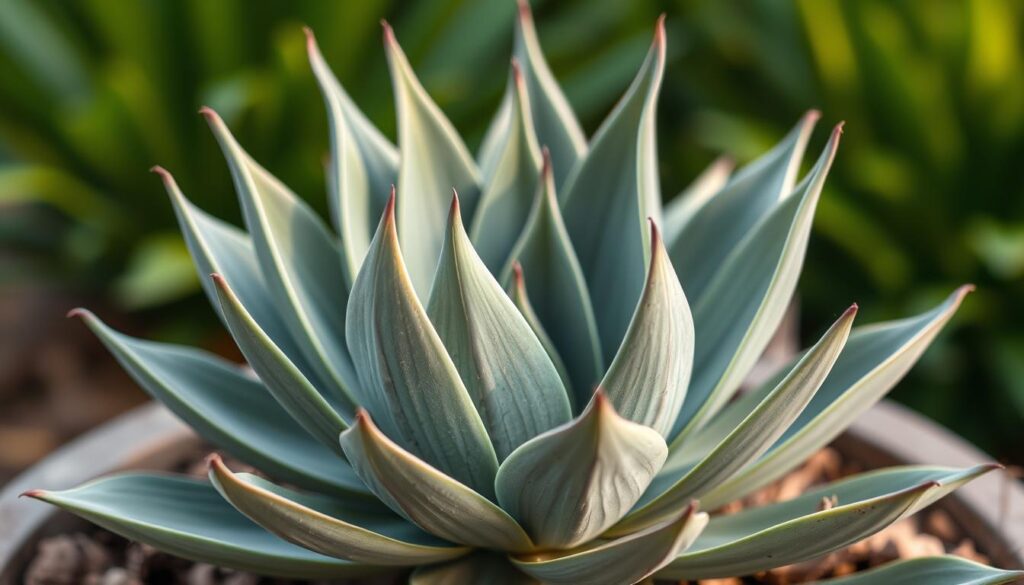I still remember the first time I laid eyes on the dwarf butterfly agave. Its compact form and vibrant colors immediately caught my attention, and I knew it would be perfect for my small urban garden. This miniature succulent, also known as *Agave isthmensis*, is a gem for any plant enthusiast looking to add a touch of beauty without needing much space.
The powder blue leaves with their prominent dark red teeth and striking red terminal spine give this plant an ornamental appeal that’s hard to match. Reaching about a foot in height and width, it’s ideal for containers or mixed-specimen plantings. When it matures, it produces a tall candelabra flower stalk adorned with bright yellow blooms, adding a dramatic touch to any setting.
Native to the southern coast of Oaxaca, Mexico, this agave brings a piece of its exotic heritage to your garden. Whether you’re a fan of cacti, succulents, or just looking for a low-maintenance houseplant, the dwarf butterfly agave is a versatile choice that’s sure to impress. Its adaptability and unique appearance make it a standout in any collection.
Preparing for Planting: My Garden Setup Essentials
Setting up the perfect environment for your dwarf butterfly agave is crucial for its success. In this section, I’ll walk you through my essential steps to ensure your plant thrives from the start.
Choosing the Perfect Pot and Location
Selecting the right pot is the first step. I opt for a container that’s slightly larger than the plant’s base, ensuring proper drainage. A pot with drainage holes is a must to prevent waterlogged soil. For location, I prefer a spot with filtered sun or morning sunlight to protect the agave from harsh afternoon heat. This balance ensures the leaves maintain their vibrant color without risking sunburn.
Selecting a Well-Draining Soil Mix
The soil mix is another critical factor. I use a mix enriched with perlite or vermiculite to enhance drainage and prevent moisture retention. This helps the roots stay healthy and avoids rot. A well-draining soil mix is especially important for succulents like the dwarf butterfly agave, which are prone to root rot in damp conditions.
| Pot Size | Soil Mix | Location |
|---|---|---|
| Container slightly larger than plant base | Enriched with perlite or vermiculite | Filtered sun or morning sunlight |
By combining these elements—proper pot selection, ideal location, and a well-draining soil mix—you create an environment that supports healthy growth and showcases the plant’s natural beauty. These setup essentials mirror my own garden practices and align perfectly with the needs of the dwarf butterfly agave.
Caring for Your dwarf butterfly agave
Once your dwarf butterfly agave is planted, the next step is to ensure it receives the right care. Proper watering, sunlight, and protection from cold are essential for its health and beauty.
Watering and Sunlight Needs
Watering is one of the most critical aspects of caring for this plant. I water my dwarf butterfly agave with about 0.5 cups of water every 12 days during the growing season. This minimal watering schedule helps prevent root rot and ensures the plant thrives. Positioning the plant near a bright, south-facing window provides the necessary sunlight without causing stress. I keep it within a foot of the window to maximize sun exposure while avoiding direct sunlight that could burn the leaves.
Managing Soil Nutrients for Steady Growth
The soil plays a vital role in the plant’s growth. I repot my dwarf butterfly agave once it has doubled in size or annually to refresh the soil. This allows the plant to absorb essential nutrients for steady growth. The soil mix should be well-draining to prevent moisture buildup, which can lead to root rot. I use a mix enriched with perlite or vermiculite to enhance drainage and support healthy root development.
Protecting Against Cold and Frost
Protection from cold is crucial, especially during winter. I bring my plant indoors when temperatures drop below 25°F to shield it from frost. This ensures the plant remains healthy and continues to thrive during colder months. The dwarf butterfly agave’s resilience as a succulent makes it adaptable to various environments, but frost protection is necessary to maintain its vibrant appearance.

By following these care guidelines, you can enjoy the beauty of your dwarf butterfly agave while keeping it healthy and strong. Regular monitoring of the plant’s leaves and overall appearance will help you adjust its care routine as needed, ensuring it flourishes in your garden or indoor space.
Planting Techniques: From Offsets to Repotting
Propagating the dwarf butterfly agave is a rewarding process that allows you to share or expand your collection. This plant naturally produces offsets close to the mother plant, making them ideal for re-propagation and container gardening.
Propagating Through Offsets
To propagate, carefully separate the offsets from the mother plant. Use a sterile tool to avoid infection. Once separated, let the offsets dry for a few days to form a callus, which helps prevent rot.
Choose a pot slightly larger than the offset’s base and fill it with well-draining soil. Plant the offset, water sparingly, and place it in bright, indirect light. Keep the soil moist but not soggy to encourage root development.
Repotting for Healthy Growth
Repotting is essential for maintaining your plant’s health. Select a pot that offers enough space for growth and use fresh, well-draining soil. This ensures the roots have room to expand and reduces the risk of rot.
During the propagation phase, minimal watering is key. Water your dwarf butterfly agave sparingly, about 0.5 cups every 12 days, to prevent root rot. Once established, you can adjust to the regular watering schedule.
My personal experience with propagating this agave has been highly successful. The offsets remain true to the plant’s original size and form, making them perfect for container gardens or small rock gardens. By following these steps, you can enjoy the beauty of your dwarf butterfly agave while keeping it healthy and thriving.
Troubleshooting and Fine-Tuning Growth
Even with the best care, challenges can arise. Let’s explore common issues and how to address them to keep your plant thriving.
Identifying Signs of Overwatering and Light Stress
Yellowing or droopy leaves often signal overwatering. Check the soil—if it’s waterlogged, stop watering until it dries out. Light stress can cause pale leaves. Adjust the plant’s location to ensure it gets bright, indirect light without direct sun exposure.
Dealing with Pests and Fungal Issues
Check for pests like mealybugs or spider mites. Use neem oil or insecticidal soap for treatment. Fungal spots require removing affected leaves and improving air circulation. Treat with a fungicide if necessary.
Adjusting Your Care Routine for Seasonal Changes
In winter, reduce watering to once every 6-8 weeks. Summer requires more frequent watering, about every 7-10 days. Monitor temperature and adjust as needed to protect from frost.
By staying observant and adjusting care routines, you can prevent issues before they harm your plant. Regular checks ensure your dwarf butterfly agave remains healthy and vibrant.

Wrapping Up My Garden Journey
Reflecting on my journey with the dwarf butterfly agave, I am reminded of how this plant has transformed my garden. Its compact size and vibrant colors have added a unique charm, making it a standout in any setting. Whether in a container or a rock garden, this agave brings a touch of beauty and resilience.
The key to its success lies in proper care. Selecting the right pot, using well-draining soil, and careful watering are essential. I’ve found that minimal watering during the growing season, about 0.5 cups every 12 days, prevents root rot and promotes healthy growth. Positioning it near a bright, south-facing window provides the perfect balance of light without direct sun exposure.
Propagating through offsets has been rewarding, allowing me to share this beauty with fellow gardeners. The process is straightforward—separate the offsets, let them dry, and plant them in well-draining soil. This method ensures new plants thrive, maintaining the original form and beauty of the mother plant.
Troubleshooting common issues like overwatering and light stress has been a learning curve. Yellowing leaves often signal too much water, while pale leaves indicate a need for more indirect light. Regular monitoring and adjusting care routines have been crucial in keeping my agave healthy and vibrant.
In conclusion, my experience with the dwarf butterfly agave has been both educational and rewarding. Watching it thrive, whether in a container or mixed-specimen planting, has been a true delight. I encourage fellow gardeners to give this plant a try, as its unique beauty and low-maintenance requirements make it a perfect addition to any garden. The satisfaction of nurturing it and seeing it flourish is a journey worth undertaking.
